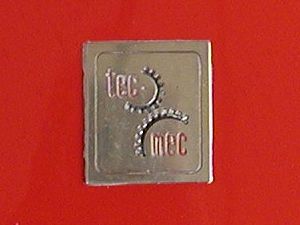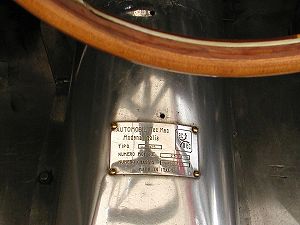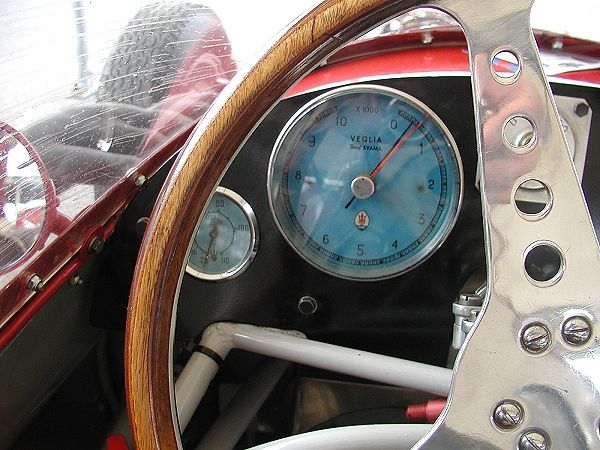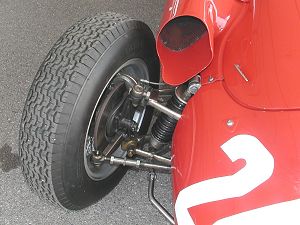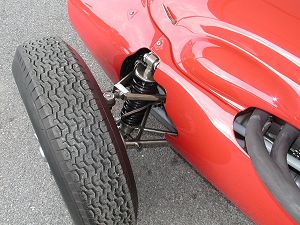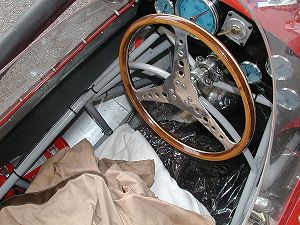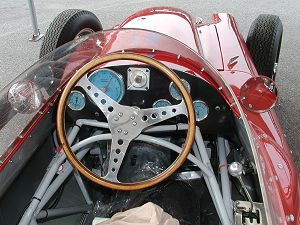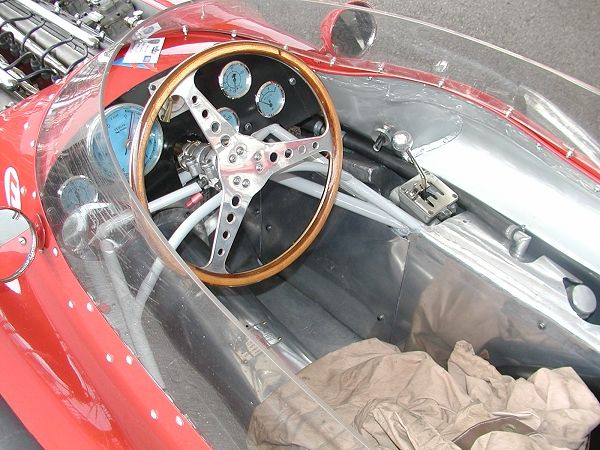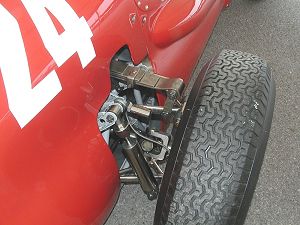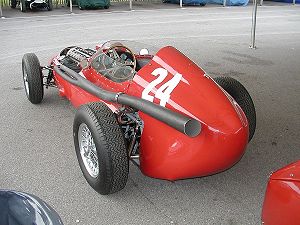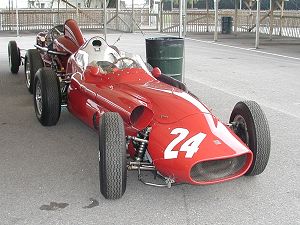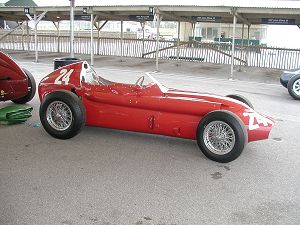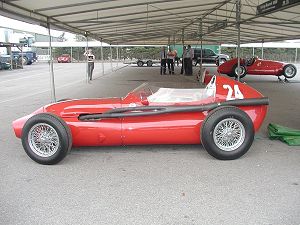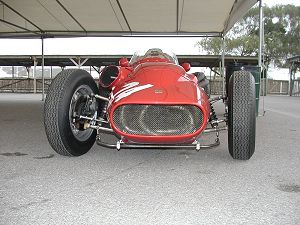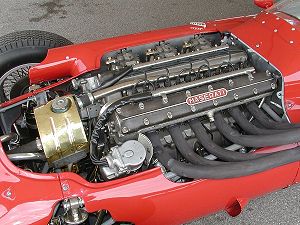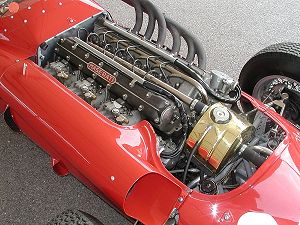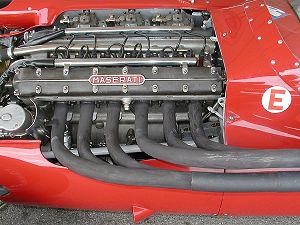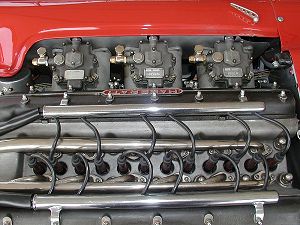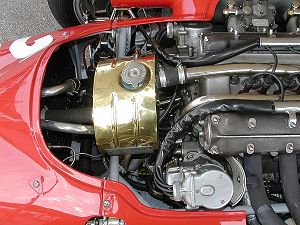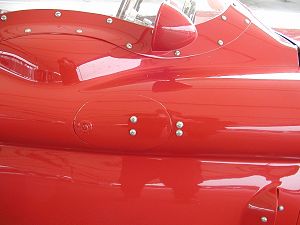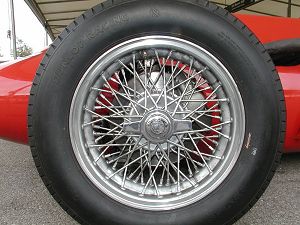In 1958, following Maserati's withdrawal from Grand Prix racing, Valerio Colotti, Maserati's chassis and transmission specialist left the company.
Colotti, aided by financial support from American Tom Meed, set up Studio Tecnica Meccanica. Collotti having worked on the original 250F project, planned to design a Formula One race car powered by the same engine as the Tipo 250F. This new car would be built around a lightweight latticework tubular chassis made from small diameter tubing giving the car an overall weight of around 550kg. Other features included rack and pinion steering, Girling disc brakes on all four wheels, independent front suspension with coil springs with adjustable shock absorbers and anti-roll bar and rear suspension by transverse leaf spring.
I would like to thank the editorial staff of AUTOCAR magazine for allowing me to print the following excerpts from the excellent article "Historic racing cars 3: 1959 Tec-Mec Maserati - Seven-Lap Wonder" written by Michael Bowler that appeared in the December 6th 1969 issue of Motor.
Valerio Colotti and the Studio Tecnica Meccanica.
"Tec-Mec Tipo F/415. This new recruit to the ranks of Formula 1 cars has been designed by the Italian engineer Valerio Colotti, responsible for the five-speed gearboxes fitted to the Rob Walker Coopers. The space frame chassis of small diameter tubes is powered by a Maserati 25OF engine of 2,493 cc which is stated to develop 265 bhp at 7,800 rpm. The five speed gearbox and differential are in unit with the final drive. Suspension is by twin wishbones all round with coil springs at the front and a transverse rear leaf spring. Girling disc brakes provide the power to stop. Wheelbase 7ft 7in (2311 mm), track 4ft (1220 mm), and dry weight 10.4 cwt (528 kg). So it was a shorter lighter 250F Maserati - a special or a factory prototype?"
"To begin at the beginning: Valerio Colotti, a design engineer, began his career at Ferrari in 1948 and became Chief of the Technical Office there under Ing. Aurelio Lampredi. In 1953 he went to Maserati and was responsible for among other projects - the chassis and gearbox/differential etc. of the 250F. Just about everything except the engine, he says, of that car. (The engine was a development of the 2-litre formula 2 unit with the bore increased from 76.6 to 84 mm x 72 mm to give 2,493cc. It was an alloy six with gear driven overhead cams and twin plug combustion chambers).
Come 1958 and Maserati was obliged to quit racing. Colotti set up his one-man design studio in a little cranny here in Modena and named it Studio Tecnica Meccanica. Then as now his main efforts were gearbox-differential units. Early on, however, Giorgio Scarlatti, the Roman race-driver, came along with the idea of building an up to date 250F special. Colotti, of course, had a good idea what a 1959 Maserati 25OF would have been, had the factory been able to continue their racing programme, and here was a pretty fair driver with an engine, gearbox/diff. etc. and a potential financial interest. So it didn't take long to design a chassis - lighter than the 1958 'Lightweight' models with double wishbone rear suspension instead of the 25OF de Dion, Girling disc brakes, and a chassis which was more of a space frame than the original four longitudinal tubes of the 250F. Work started in the garage of the apartment of an ex-Maserati mechanic, Giuseppe Consoli (who in 1969 was back again with Maserati and was one of their chief tuners and test drivers).
The project was pretty well under way when Hans Tanner, a Swiss motoring journalist, returned from the 1958/9 Tasman series. He took an interest in the Tec-Mec programme and decided that he would like to become un patron with a partial financial involvement. Come Spring 1959 and Gordon Pennington, a wealthy Floridan, arrived in Modena to buy and later race Italian cars, primarily Formula Junior. By chance he was staying at Tanner's hotel and the inevitable happened; Pennington agreed to sponsor the Tec-Mec project at a time when it was beginning to get bogged down. Scarlatti then sold what he had invested in the venture to Hans Tanner and Gordon Pennington. At this point Tanner decided to call his new company 'Tec Mec Automobili' to give some continuity at the risk of confusion with Colotti's budding 'Studio Tecnica Meccanica'. Exit Colotti, understandably, from company and project; he then changed his company's name to G.S.D. (Gear Speed Developments S.p.A.), and Tanner and Pennington moved to the other side of town.
Consoli stayed with the car and completed it by late summer 1959, under the new owners, who were not apparently engineers in their own rights. Bob Said, an American racing friend of Tanner's, tested the car at Modena as did Piero Drogo, later a body designer. Jo Bonnier also tried the car and was not over-complimentary - his considered opinion was unprintable; Scarlatti tried again and apparently said much the same thing in Italian. But the car was basically right; it hadn't been set up correctly due to the usual lack of time.
Though the car was not ready to race at the Italian Grand Prix at Monza that year, it was sorted out pretty well soon after and it was decided to enter it for the US Grand Prix at Sebring, Florida, in December 1959. By this time Tanner and Pennington's partnership had dissolved, with the car going to the latter.
Fritz d'Orey, a young Brazilian racing driver, had been driving various cars in Europe during the 1959 season-formula Junior, GTs, etc - and also Pennington's 250GT Ferrari. He was based in Modena and got along well with Pennington. He was pretty quick and quite fearless, so he was a natural to start with the Tec-Mec at the American Grand Prix. The car qualified 17th out of 19 -next to the last row. After seven laps the car retired due to 'oil leakage'.
Colotti recalls that there was to be a Daytona record attempt but the first try resulted in a broken con rod; it was at this time that d'Orey had a bad accident and everything ground to a halt. Nothing was heard of the car on the tracks after this, and it lay on a trailer in a garden in Miami until Tom Wheatcroft acquired it.
So that's the story of the Tec Mec as we know it now.
The Tec-Mec F 415.
Looking first at the design, I noticed that the car had an auxiliary front anti-roll bar strapped underneath the original. This and the removal of one leaf from the rear spring completely changed the weight transfer without upsetting the roll characteristics. So the car now understeers and keeps its rear wheels on the deck when cornering; this is a recent modification, incidentally. The transverse leaf spring is mounted on two points so provides more stiffness in roll than in bump; with upper and lower wishbones it has no location function. The front wheels are set with rather more negative camber than was ever fashionable, but tyres of that era were considerably less sensitive to camber change.
Rear uprights and front kingposts come from Formula 1 Coopers and the steering rack is from a Cooper sports car of around 1950. The column follows a particularly devious route with no less than five universal joints. In overall layout the tubular space-frame chassis doesn't look that different from a 250F's with basically four longitudinal tubes cross braced at intervals, but in the Tec-Mec the tubes are lighter and there are more of them; you can see quite a battery of them as you sit in the cockpit. The search for lighter than "lightweight" reduced the weight to a claimed 10.4 cwt, some 2½ cwt. less than a 250F. As with the 250F, the gearbox is integral with the final drive with the linkage on the right-hand side.
Rumour had it originally that the body used magnesium panels but ASnselmo Gentilini (now with Piero Drogo at Carrozzeria Sports Cars, Modena) made it up with aluminium; the centre section wraps almost the whole way round and is fastened under the lower rail with the sepdrate flooring on top of this.
Whereas 250F Maseratis use part of the rear bodywork as the fuel tank with the oil tank vulnerably behind, the Tec-Mec has an internal 30-gallon tank behind the driver and keeps the 4½ gallon oil tank alongside him on the right, just behind the gear lever.
The engine is a straightforward 250F unit with a large valve head; this is an alloy six-cylinder engine with twin gear-driven overhead camshafts. Dry sump lubrication uses three oil pumps, two scavenge and one pressure, with a front mounted oil cooler of the normal radiator type rather than the 250F's gilled tubes; this sits in front of the water radiator which has a separate header tank.
The cockpit is fairly spartan with a comfortable seat looking rather out of place in a sea of tubes and naked aluminium; you have to be rather careful getting in to avoid the perspex screen and the delicate bodywork. The upper steering column needs two bearings which are suspended in a complex of tubes which make up a scuttle hoop; the wood-rimmed aluminium wheel is very similar to the original fitment. As usual, instrumentation is kept down to the minimum that you can be expected to read at 140 mph; a rev counter with tell-tale needle is on the left, and three small dials on the right of the column show oil and water temperatures and oil pressure. Just in front of the seat is a small fire extinguisher and the chassis plate: Automobil Tec Mec, Modena ltalia, Tipo F 415, Motore 2523, Chassis Prototipo. Tipo F 415 is the number used by Tanner, whereas Colotti more realistically called it Tipo 11." Copyright: Haymarket Magazines - © 1969-2002. All rights reserved. |
